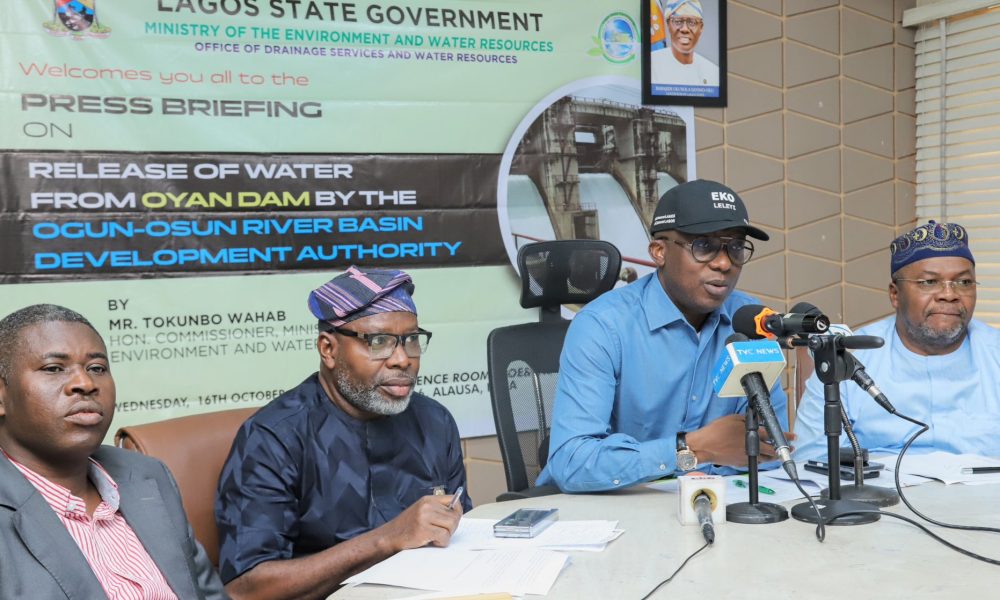The Lagos State Government has alerted residents and property owners at the Ogun River Banks to relocate after the Ogun-Osun River Basin Development Authority (OORBDA) commenced the staggered release of water from Oyan Dam.
The Lagos State Government issued the alert through the Commissioner, Ministry of the Environment and Water Resources, Tokunbo Wahab who spoke during a press briefing on Thursday.
“We, hereby, alert residents and property owners at the Ogun River Banks to be ready to relocate to higher grounds as the Ogun-Osun River Basin Development Authorities commence staggered release of water from Oyan Dam,” Wahab said.
“Lagosians needed to be alerted on the commencement of release of water to maintain the sanctity of the dam and it’s socio-economic implications for Lagos State.
“It is crucial to understand that the dam’s annual operations are informed by real-time hydrological data, rainfall predictions from the Nigerian Meteorological Agency (NIMET) and flood outlooks from the Nigeria Hydrological Services Agency (NIHSA).
“These sources guide the water release decisions to ensure both flood control and the integrity of the dam.”
Wahab said the Lagos State Government and OORBDA acknowledge the concerns raised regarding the release of water from the dam and it’s impact on surrounding communities, particularly those along the Ogun River water channels extending into Lagos.
According to him, a detailed operational report by OORBDA states that the total water released from the dam this year as of October 12, 2024 stands at 1,484.2 million cubic meters (mcm) which remains below the average synthesized annual flow volume of 1,770 mcm.
Although rainfalls across the Oyan River catchment area have been significant with a cumulative 984.1 mm recorded this year, he said it remains lower than last year’s 1,540.8 mm and is within safe operational levels.
Wahab explained that 62.1% of the dam’s flood control capacity remains intact with the dam not under any imminent threat of releasing excess water beyond safe limits.
The commissioner added that this has been made possible through the collaboration of Lagos with OORBDA.
He said the Lagos State Government fully recognizes the challenge faced by residents in affected communities which include Kara, Mile 12, Agiliti, Ikosi Ketu, Owode, Ajegunle and Odo-Ogun as reported.
“However, I want to emphasize that while the flooding experienced in these areas has often been attributed solely to water released from the Oyan Dam, this is not entirely the case,” Wahab said.
“In reality, the downstream section of the Ogun River is influenced by a complex network of over 52 tributaries, all of which converge and contribute to rising water levels in the affected areas.
“These tributaries, combined with rain-induced runoff significantly exacerbate the flood situation which makes it a critical point to consider when addressing flood management strategies for this region.”
He explained that in an effort to reduce the flood risks and ensure the free flow of water within the Ogun River system, OORBDA recently flagged off the dredging of the Ogun River downstream from the Ikorodu to Isheri axis (Ajelogo, Owode-Elede, Ajegunle and under deck-on-pile of Itowolo Bridge) for the water released on Friday, September 13, 2024.
Wahab added that some right-of-ways along the catchment areas were protected and restored while the dredging project was a proactive measure to deepen the river channel and increase its capacity to convey water, thereby reducing the likelihood of flooding during periods of high inflow.
He said the Lagos State Government would continue to monitor the situation closely and collaborate with relevant agencies and affected communities to address humanitarian concerns, particularly for vulnerable groups like women, children, the elderly and people living with disabilities.
“I wish to appeal once again to our people to support our efforts by complementing the State Government through regular clearing of drains in their frontages to ensure free-flow of storm water as well as to desist from dumping of refuse into drainage channels and roads,” Wahab said.

